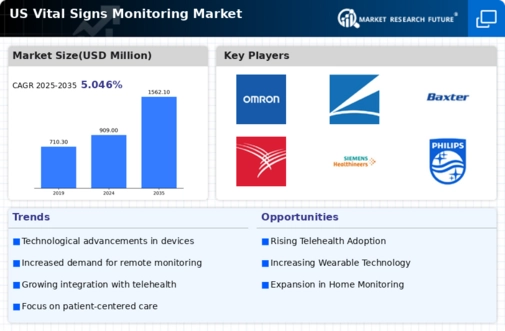Aging Population and Healthcare Needs
The aging population in the US is a significant driver of the vital signs-monitoring market. As individuals age, they often experience multiple health issues that require regular monitoring of vital signs. By 2030, it is projected that nearly 20% of the US population will be over 65 years old, leading to increased demand for healthcare services. This demographic shift necessitates the development of monitoring solutions tailored to the needs of older adults, who may require assistance in managing their health. The vital signs-monitoring market is expected to grow as healthcare providers seek to implement solutions that cater to this demographic, ensuring better health outcomes and quality of life for seniors.
Growing Demand for Telehealth Services
The increasing adoption of telehealth services is significantly influencing the vital signs-monitoring market. As healthcare providers expand their telehealth offerings, the need for reliable monitoring solutions becomes paramount. In the US, telehealth visits have surged, with estimates indicating a growth of over 50% in recent years. This shift towards remote healthcare necessitates the use of vital signs-monitoring devices that can provide accurate and timely data to clinicians. The vital signs-monitoring market is likely to benefit from this trend, as healthcare systems invest in technologies that support remote patient monitoring, ultimately improving access to care and patient satisfaction.
Focus on Preventive Healthcare Strategies
There is a growing emphasis on preventive healthcare strategies within the US healthcare system, which is driving the vital signs-monitoring market. Healthcare providers are increasingly recognizing the importance of early detection and intervention in managing health conditions. This shift towards preventive care is reflected in the rising investments in monitoring technologies that enable proactive health management. The vital signs-monitoring market is likely to see substantial growth as healthcare organizations adopt these strategies, aiming to reduce healthcare costs and improve patient outcomes. By leveraging advanced monitoring solutions, providers can identify potential health issues before they escalate, ultimately fostering a healthier population.
Increasing Prevalence of Chronic Diseases
The rising incidence of chronic diseases such as diabetes, cardiovascular disorders, and respiratory conditions is a primary driver for the vital signs-monitoring market. In the US, approximately 60% of adults have at least one chronic condition, necessitating continuous monitoring of vital signs to manage health effectively. This trend underscores the need for advanced monitoring solutions that can provide real-time data to healthcare providers. As healthcare systems increasingly focus on preventive care, the demand for devices that can track vital signs remotely is expected to grow. The vital signs-monitoring market is projected to expand significantly as healthcare providers seek to enhance patient outcomes through timely interventions and personalized care plans.
Technological Advancements in Monitoring Devices
Technological innovations are transforming the vital signs-monitoring market, leading to the development of more sophisticated and user-friendly devices. Recent advancements include the integration of wireless connectivity, enabling seamless data transmission to healthcare providers. The introduction of smart wearables and mobile health applications has made it easier for patients to monitor their vital signs from home. In 2025, the market for wearable health technology is anticipated to reach $60 billion in the US, reflecting a growing consumer preference for health management tools. These innovations not only improve patient engagement but also facilitate better data collection for healthcare professionals, thereby enhancing the overall quality of care.





















Leave a Comment